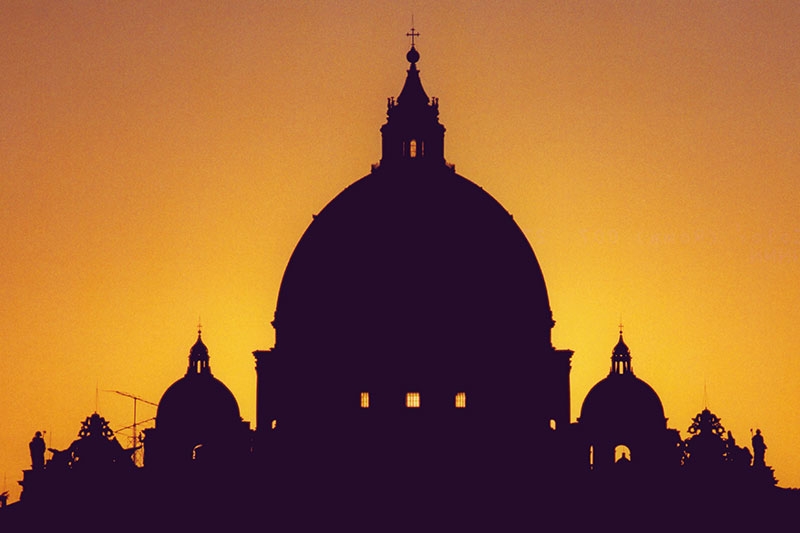Vatican City through time

In ancient times, the word Vatican referred to the swampy area on the right bank of the Tiber River, including the area between Ponte Milvio and today’s Ponte Sisto.
During the royal period and throughout the Republican Age, the territory was known as Ager Vaticanus and stretched as far north as the Mouth of the Cremera, and as far south as the Janiculum Hill. The earliest records of the use of the word Vaticanum to refer to the area that roughly corresponds to today’s Vatican City State, date back to the 2nd century A.D., in the Imperial Age. In the Roman era, the area outside the city of Rome was reclaimed and villas began to appear, among them the gardens of Agrippina, mother of Caligula (37-41 A.D.), as well as a vast necropolis along its main arterial roads. Caligula had a small circus built in his mother’s gardens, as a training site for charioteers (Gaianum). Later renovated by Nero (54-68 A.D.), tradition says it was the place where Saint Peter was martyred during the great persecution of Christians in 64 A.D.
Several clusters of tombs were found along Via Trionfale that leads north from the Basilica of Saint Peter towards Monte Mario, and a necropolis was discovered along Via Cornelia leading west, in which the tomb of the Apostle Peter was found. The presence of Peter established the topographic fulcrum of the area, and since then and for two whole millennia, it remains one of the most important Christian pilgrimage sites. Indeed, spurred by the desire to be close to Saint Peter, many ended up being buried close to him. The Necropolis was buried during the construction of the Basilica dedicated to the Apostle, built by Emperor Constantine (306-337 A.D.) which defined later developments in the area. After the Edict of Milan in 313 A.D. with which he granted Christians the freedom to practice their religion, some time around 324 A.D., Emperor Constantine started the construction of a large church with five naves, a transept and a terminal apse, at the centre of which, lay the tomb of Saint Peter. It included a stairwell and a quadriporticus, which the non-baptized could not enter.
In the meantime, Nero’s circus fell into ruins, many of its stones having been removed for use in the construction of the new church, which did not take long to become a new source of attraction to the city Years later, Leo IV (847-855) chose the same site, in memory of Peter, to build the first walls of the civitas, which became known as Leonine, the spiritual heart of Rome throughout the Middle Ages and the Renaissance. Despite the fact that the popes still lived in the Lateran Palace, buildings began to be appear in the area adjacent to Saint Peter’s Basilica in the Middle Ages. The first palace was completed in the Middle ages, during the Pontificates of Eugene III (1145-1153) and Innocent III (1198-1216), and expanded between the end of the 1200s and the early 1300s, when the Leonine Walls underwent restoration works. However, in 1309, the Papal See was moved to Avignon and both Rome and the Basilica of Saint Peter were abandoned for over a century. It took 50 years from the Pope’s return in 1377, to polish up the city. By the mid-1400s, the idea of an integral reconstruction of Saint Peter’s Basilica began to surface.
Pope Nicholas V (1447-1455) commissioned architect, Bernardo Rossellini, to draft a project for the expansion of the Basilica, with a new apse, that was more protruding than the one Constantine had built. Its construction was left in its initial stages, as Turkish groups advanced ever closer, culminating in the fall of Constantinople and the abandonment of the project. Between 1477 and 1480, Pope Sixtus IV (1471-1484) ordered the construction of a large chapel, which was later named after him, the Sistine Chapel. Decorated with frescoes by the greatest Italian painters of the time, it was inaugurated on 15 August 1483. Julius II (1503-1513) made many changes that radically changed the citadel. He began the demolition of Constantine’s Basilica and started the construction of a new Saint Peter’s Basilica. He built the famous Belvedere courtyard that connects the Villa Belvedere of his predecessor Innocent VIII (1484-1492) in the north, to the medieval buildings in the south, and he commissioned Raphael and Michelangelo to paint frescoes in the papal apartments and in the Sistine Chapel, respectively.
Additional work took place during that century. After a series of events, the Basilica of Saint Peter was designed and Michelangelo began work in its fulcrum in the mid-1500s. The Church was covered by a grand vaulted cupola by Giacomo Della Porta. It was later further expanded by Maderno in the early 1600s with the addition of two aisles in the longitudinal section, and completed by Bernini in the second half of the 17th century, with the grand square and the two semicircles of four rows of columns which give it its baroque look, and connects the Basilica to the rest of the city.




